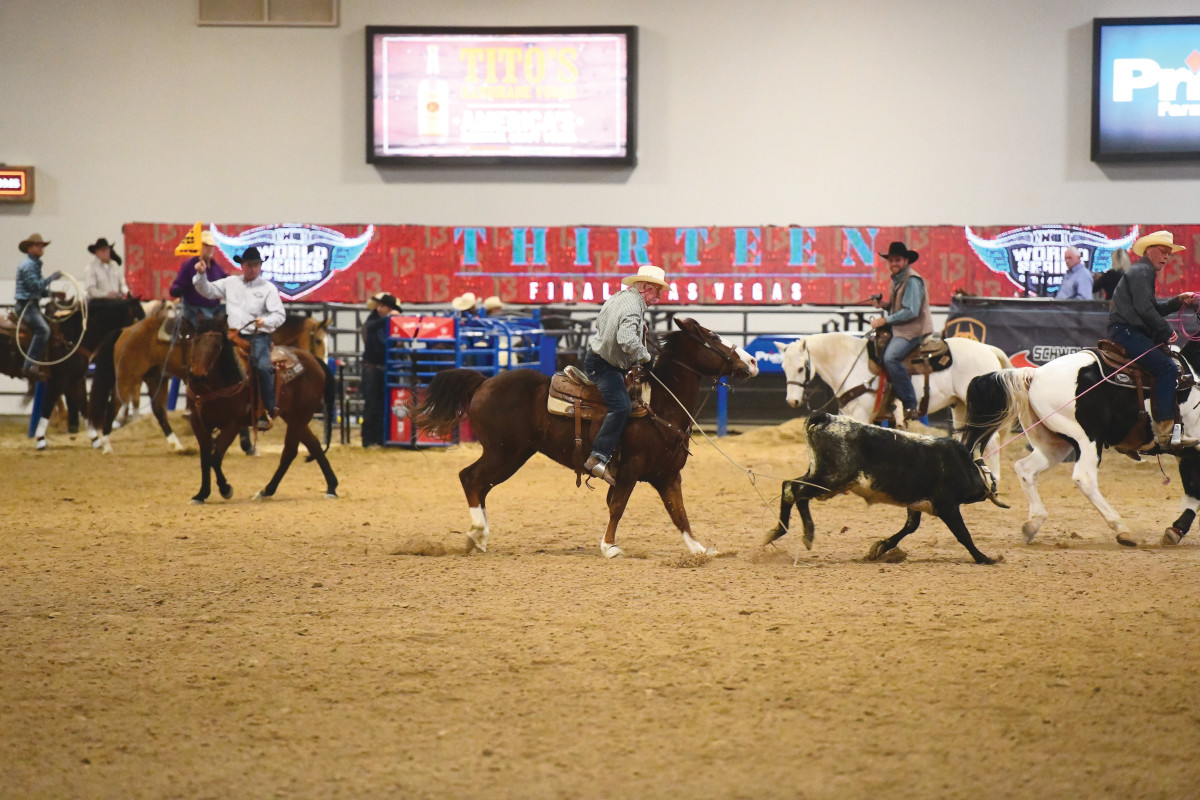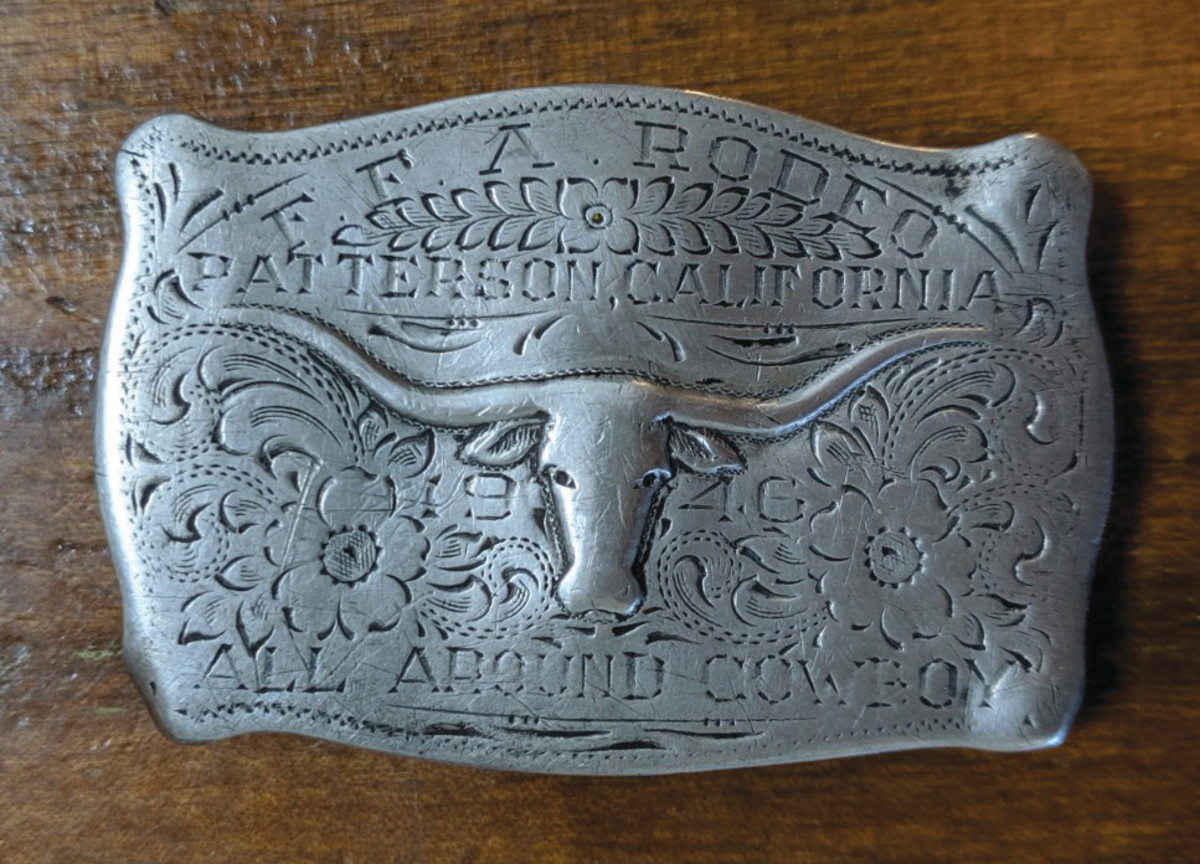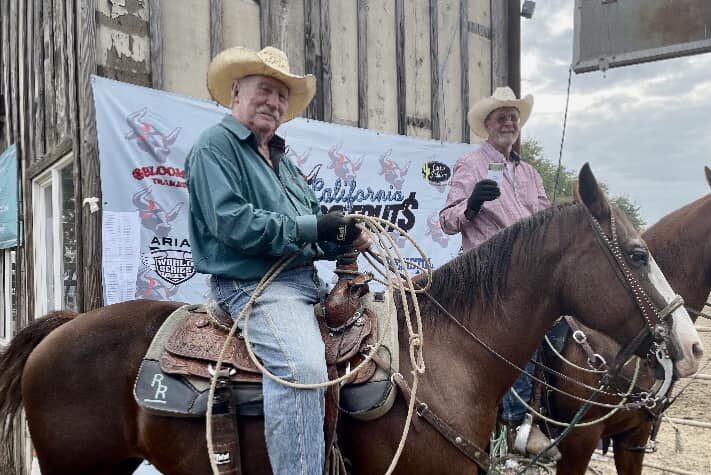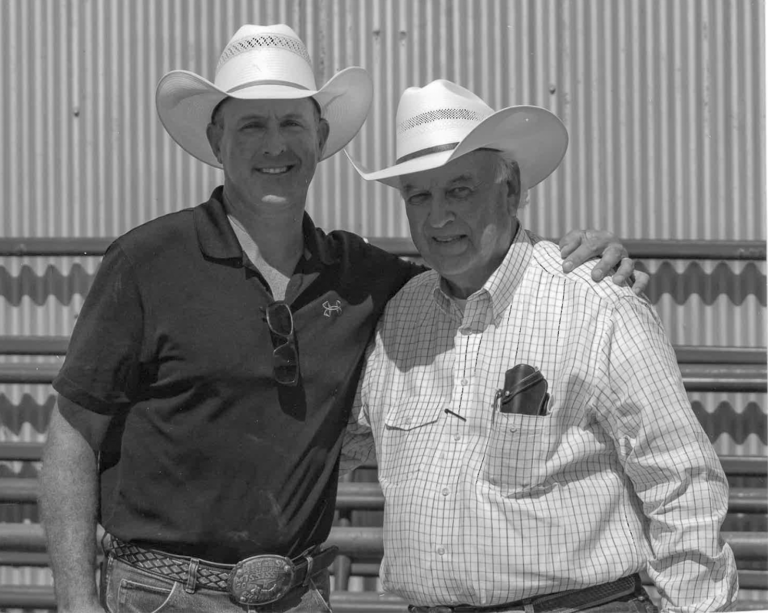“I won my first belt buckle in 1946. I was a junior in high school.”
In March, Red Rightsell was relaxing in his chair, awaiting warmer weather and the opportunity to go to the next roping.
“It’s been so cold this winter,” he said, “but we’re getting the horses in shape and trying to get everything ready to go.”
Rightsell is a natural conversationalist, humble in his accomplishments, yet eager to talk about all things roping. Without being told his birthday, it’d be hard to imagine he’s in his 90s. His roping career began when a family moved to his Patterson, California, hometown.
“The kids were roping and I’d just seen what they were doing and I tried to copy that,” Rightsell explained. “They had a high school rodeo and I won the all-around and the calf roping. That was my first buckle.”
The first of many. Rightsell took a job on a ranch in high school and got to pasture roping, then joined the RCA—predecessor of the PRCA—in 1952.
“I team roped and calf roped both. I roped calves until I sprained an ankle so bad I couldn’t do that anymore. I went to mostly California and a little bit of Nevada. But I stayed mostly in California.”

In those days, California was a good place to be, too.
“I had a brother-in-law that I roped with for years. My wife’s brother, Julius Boschi. We worked together. He roped pretty tough. In 1962, I believe it was, he won the Finals in Las Vegas, wait, in L.A. They had the PRCA Finals in ’62, ’-3 and ’-4. He roped with Les Hirdes in ’62 and won the National Finals, won the average.
Read about more icons:
Jim Riley: “The Adventurer” and Founder of Dynamite Arena
“I roped with Al Hooper that year,” Rightsell continued. “And in ’64 then, I roped at the Finals with Ace Barry. He was quite a kid. Ace was a wolfy little boy, kind of ahead of his time. Now, in today’s world, the kids from 8 on up is beating everybody, but Ace was pretty wolfy.”
Between then and now, Rightsell has seen a thing or two in team roping, and a world of change in the sport.
“In those days, you know it was before the nylon ropes came out,” Rightsell said. “So you wrapped your saddlehorn with a cotton rope. [And] team roping was not a real popular thing. [It] was just kind of the old man sport, so to speak.”
When Rightsell did travel to Arizona for some winter roping, he found a whole different environment than what California was offering at the time.
“Back in the ’60s, we went down there,” he said. “Three or four of us went together. We would go down there and spend two or three weeks in Arizona. But in those days, they didn’t dally. It was a team tying world. And California didn’t really have the team tying horses the Arizonans had. So, it was a little tough down there.”

And though he knew good horses in his rodeo days, Rightsell believes they’ve carried the bulk of the change in the sport.
“I do believe the horses are better today. It’s just so much different. The horsepower is so much greater today. You don’t want to say that ‘cause there’s going to be a lot of guys that argue about that. But the horses today are … I’ll say it this way: In the team roping, the header had the speedhorse. But in today’s world, you best have a heel horse that can catch the head horse.”
As a lifelong heeler, Rightsell certainly means no disrespect to the heel horses of yesteryear. In fact, his own mount has maintained a special place in Rightsell’s memory over the past many decades.
“Back through the years from ’59 into the ’70s, I had a mare that was just out of this world. She was such a good horse. And could run hard. And strong. And that really helped me. That let me rope with some of the better guys. I think maybe they knew she was a nice horse, too.
“I bought her from a guy whose name was W.W. Cox, and I just called her WW. She was just a brown mare with a stripe down her face. She was a doll. Fact is, I’m sitting here in the living room watching television, and I look over at the wall there and her bridle is hanging over there. When I quit riding her, I kind of said to myself, if I ever find one good enough, I’ll let it ride this bridle, but I never did.
“But as far as being in rodeo in them years, she was the greatest thing for me. I won’t say I had an advantage over everybody, but I could keep up with everybody.”
Fact is, Rightsell is still keeping up with everybody. In 2018, he traveled from his Windsor, California, home to Las Vegas to rope in the Ariat World Series of Team Roping Finale, and just this past October, he was in Reno, having qualified for the ACTRA Finals where—though he didn’t win his division—he did come home with a pretty spectacular Lifetime Achievement Award buckle from the organization, which Rightsell directed for years.
“I couldn’t believe that happened this past year at Reno. I was sitting over there in the grandstand and [my friend] Suzanne came down and got me. I thought she wanted me to come look at something she wanted to buy, and I said, ‘Oh yea, here we go,’ but the next thing I know, they got me in the arena and they’re giving me this award.
“If I had had to make a speech, I couldn’t have done it. I choked up. I never had any idea that that’s what was going to happen. Boy, I couldn’t wait to get back out of there because I couldn’t have said a word to anybody outside of thank you, and that’s it.
“But it was great. I’m very proud of that buckle. I knew the guys who’d got that award before. I thought it was a great deal for a guy to get something like that. That was a great deal. I was very proud of that.”
Considering his 75 years in the sport, it doesn’t come as a surprise to know that Rightsell has a veritable shelf-full of buckles, but to hear him talk about a few special prizes he remembers throughout the years is a pleasure.
“If we’re bragging about poor, Ol’ Red, I joined the RCA in 1952 and the first saddle I ever won was in 1999. It was at a place down in Sacramento. Cresta put on a roping over there. It was a 4-steer average, and my son, Jimmy, and I won the saddle for that roping. Then, I came back the same afternoon with the Cresta daughter, who was I think 14, and won another saddle with her the same day.

“It took me that long. But I will say one thing for the rodeo world, back in those days, you know, earlier days, they didn’t give away awards like saddles. I won the all-around at La Grange, that was an amateur rodeo, and I split the all-around, high-money winner with a saddlebronc rider named Harry Rose. He team roped and rode saddlebroncs. And so, they come down with a little headstall and they said, ‘Here, you guys won this. You want to cut a card for that?’ I cut a three and Harry cut a nine, so he won the headstall. So, that was my first big prize that I didn’t win.”
Rightsell’s favorite, though, is in regard to a buckle he wears to this day.
“In 1977, I went to the rodeo over in Gardnerville, Nevada, with Julius Boschi’s son, John Boschi. And John made the RCA pretty famous; he was pretty good. He won Houston one year. He was that kind of a cowboy. So, I let this guy, Randy Lovett, ride my head horse over there. And he roped with John, and they roped a steer in 9.2 and went to the lead in this roping. And I’m standing there with Andy Meese, who is the partner of this guy, and I said, ‘Welp, there I go. Ol’ John has never roped two steers in a row by two feet in his life, I’m out!’
“So they come riding back and they’re pretty happy and Andy immediately tells John what I said. It just so happens, we came back and was 9-flat on the steer, John and I. And I’ve got the buckle on right now.
Read about more icons:
Rodeo Raised & Heel Bound: Sherry Robinson
“John’s probably one of the best friends I had. He’s my nephew, but he would be the first guy to help me. Anyway, to this day, he will bring that up and say, ‘What the hell did you think about me?!’ It was hilarious. I’ve worn that buckle since that day. I got it on right now.”
Rightsell has stories and buckles for days, as well as insights on team roping’s history and its future, too (he thinks the sport is here to stay). But he knows he’s still roping today, at 91, for one reason.
“If it wasn’t for the numbers system, I don’t think I’d be roping today. I know I wouldn’t. What the pros can do today … you know the average roper wouldn’t be able to keep up with them. So, I can go to, say, a #8 at a World Series roping and feel confident that I could place in those ropings. The number system has saved a world of ropers, I feel.”











